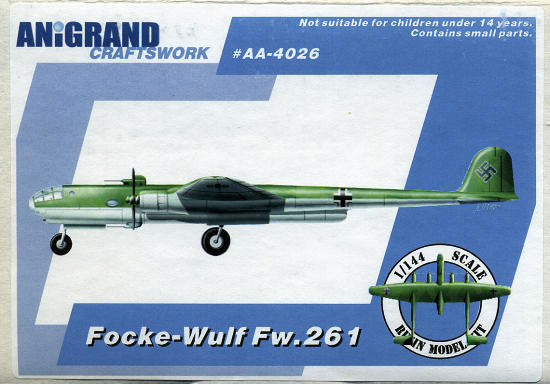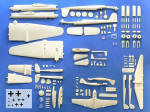
Anigrand 1/144 Focke-Wulf FW-261
| KIT: | Anigrand 1/144 Focke-Wulf FW-261 |
| KIT #: | AA-4026 |
| PRICE: | $90.00 MSRP from www.NostalgicPlastic.com |
| DECALS: | generic options |
| REVIEWER: | Scott Van Aken |
| NOTES: | Resin; price includes shipping in US/Canada |

| HISTORY |
In 1941, the Luftwaffe Fw.200 Condors were constantly shot down by Hawker Hurricane in the Atlantic and North Sea theater. The RLM ordered industries to propose a new machine which could enable to carry more defensive armaments. Focke-Wulf responded with the P.0231-0225 very long-range bomber design, later given the Focke-Wulf internal designation as the Fw.261. The Fw.261 layout featured a central gondola and two separate tail booms, in order to guarantee the rear gunner an unobstructed field of fire. Two pairs of Mk.108 machine gun turrets were installed under the nose to provide extra protection against the British fighter head-on attacks. As well as being a long-range maritime reconnaissance aircraft, the Fw.261 was also intended for the anti-shipping role. As the RLM accepted the improved Fw.200C which featured more powerful engines and increased armaments, the Fw.261 project was not proceeded with beyond the drawing board.
| THE KIT |
 The
kit arrives in a sturdy box in which is a segmented bag containing the kits. It
is plural because in addition to the FW-261, there are kits of similarly shaped
twin-boom planes. Specifically the FW-189v6, BMW Strahljager P.III, Arado E.500
and Blohm und Voss Bv-196. Of all these only the FW-189v6 heavily armored attack
bomber prototype actually made it off paper and into the air.
The
kit arrives in a sturdy box in which is a segmented bag containing the kits. It
is plural because in addition to the FW-261, there are kits of similarly shaped
twin-boom planes. Specifically the FW-189v6, BMW Strahljager P.III, Arado E.500
and Blohm und Voss Bv-196. Of all these only the FW-189v6 heavily armored attack
bomber prototype actually made it off paper and into the air.
My inspection of the parts showed that there were a most welcome decrease in the number of molding glitches. Only a few parts had air holes on the trailing sections of some bits and none of the major problems that often plague short run kits like this. The smaller kits have single piece fuselage and wings with some having the seats already molded in place In many cases the landing gear legs and wheels are one piece to help make them sturdy. The prop driven ones all have separate hubs and prop blades. The blades will need to be handled with care as they are quite thin. The smaller plane that has a nose wheel will be tail sitter as the solid fuselages will not provide space for any weight. The main subject appears to provide sufficient room in the forward fuselage and also has the main gear set somewhat far back. The rest have tail wheels. These also have clear resin canopies. I was hoping that the clear sections would have recesses around them as in the XB-19 as that made it so much easier to mask. These have standard raised framework, but it is well defined so should not be too much of a bother.
Decals are generic and are basically insignia and pieces of swastika that you match together. Most schemes are late war greens, but really, you can paint these any way that you want. One of the beauties of Luft '46. Instructions are a pair of upper and lower photos of each model with the parts placement noted. Works well enough that those who have reached this stage should not have any trouble.
| CONCLUSIONS |
Always nice to see these sorts of kits. Having them in 1/144 makes them much more likely to be built as one doesn't have to wonder where to put it when done. The relatively small parts count means they will build fairly quickly as short run resin kits go. These might not be a bad set of planes for a beginner. They can start with the really simple smaller planes and work up to the more complex ones. Definitely a good bang for the buck with this one.
| REFERENCES |
Instruction Sheet
January 2009 If you would like your product reviewed fairly and quickly, please
contact
me or see other details in the
Note to
Contributors.